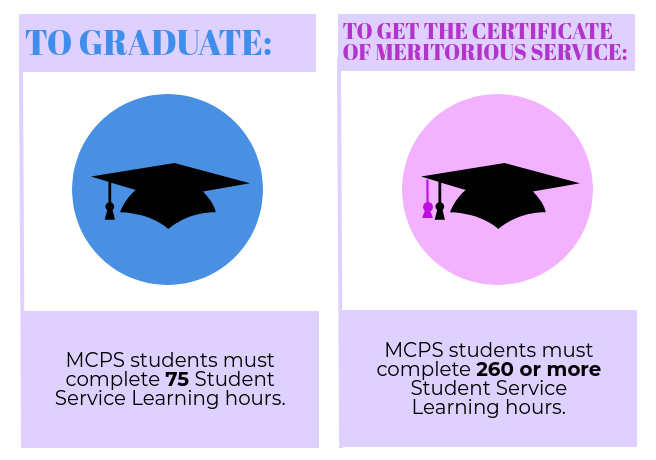Graphic by Selina Ding.
Pro-Con: Continue mandatory student community service policy
January 22, 2018
Currently, Montgomery County Public Schools requires 75 SSL hours as a graduation requirement for all students. The Black & White looked at the benefits and harms of the mandatory hours.
SSL hours should remain as a graduation requirement
I spent the summer of my freshman year in the mountains of rural China with no running water or technology. My main goal was to complete my 75-hour Student Service Learning requirement to graduate, but I left my trip with a different outlook on life.
Community service allows students to take a break from monotonous schoolwork and try new activities. The requirement forces students to take initiative and responsibility for finding volunteer opportunities at nonprofit organizations in the community or abroad. From cleaning up trash around the neighborhood to going overseas for a service trip, organizations provide a wide variety of MCPS-approved options.
SSL hours should remain as a graduation requirement for Maryland schools, because it guarantees all students an opportunity to try new things and help around the community or even abroad.
Students are able to take part in volunteer programs that allow them to interact with people they wouldn’t normally talk with. I was personally tentative about my month-long service trip to China because I didn’t want to spend so much of my summer volunteering. But living in a poverty-stricken area of rural Gansu and seeing how hard the students there worked to succeed made me take a step back and reassess what was important to me. When summer break ended, I returned with a new perspective on life, new friends and 400 SSL hours.
With the requirement, students have the opportunity to try new things and perhaps develop new interests along the way. Students often view volunteer work as a waste of time, as they would rather have fun with friends, dedicate time to their favorite extracurricular activities or work a job to earn money. So, instead of considering volunteering, many will opt for a paying job when given free time. The 75-hour graduation requirement ensures that all students give volunteering a chance.
Even though 75 hours of community service seems like a daunting task, it doesn’t actually take up that much time. Many students finish their SSL hours in middle school, and even if they don’t, one summer of volunteer work could result in more than enough hours. Due to the short amount of time students must spend to complete the requirement,community service is, at worst, seen as a mild inconvenience.
In exchange for a renewed outlook on life and a sense of responsibility, 75 hours isn’t a hefty price to pay. Considering the amount of time spent in school, there’s no harm in spending a little more and learning something new.

12
What are some of your interests?
digital art
Why did you join the Black and White?
peer pressure
What's your favorite vegetable?
zucchini
Involuntary volunteering: SSL shouldn’t be required
MCPS justifies mandatory SSL on the basis that it provides students with the “knowledge, skills, attitudes, and career exploration opportunities that lead to effective citizenship in an increasingly diverse and interconnected world,” according to their website.
In an ideal world, volunteering would teach students the value of community service so they are more likely to volunteer in the future. But if volunteering is required, what should be a choice becomes a chore.
MCPS and the Maryland Education Department should remove the 75-hour service learning diploma requirement. The requirement is time-consuming for busy students and largely fails to achieve the stated goals of making students more engaged citizens.
Maryland was the first state in the nation to require community service to graduate. Nationwide, only Maryland and D.C. have this requirement, according to a 2014 report by the Education Commission of the States. Although the state claims to be leading the way in this aspect, no other states have followed suit.
After the requirement was implemented in 1992, there was an overall long-term decrease in community service among public high school seniors in Maryland, a 2013 Economics of Education Review study reported. The study cites reactance theory, which suggests that when individuals are forced to do something, the actual or perceived unfair loss of freedom leads to a negative reaction. Forcing students to complete community service hours actually dissuades them from volunteering in the future.
The requirement also makes it difficult for busy students to graduate. It can be particularly challenging for students who participate in many extracurricular activities or work a job to complete their hours. Removing the requirement would create more flexibility in students’ schedules so they can explore what they’re truly interested in.
While the benefit of volunteering is indisputable, making it mandatory contradicts the definition of volunteering: freely offering to complete a task. Volunteers should be passionate about their work—but forcing students to volunteer often has the opposite effect, leading them to take on menial tasks in which they have no interest.
Volunteering should be an important growth experience for the student—it should offer a chance to contribute to the community, not just fulfill a graduation requirement. The value of volunteering shouldn’t be defined by the number of SSL hours logged, but rather by the valuable experiences gained when students choose to volunteer.

12
What are some of your interests?
Writing, running, music
Why did you join the Black and White?
I love writing and reading the news!
What's your favorite vegetable?
Edamame
